How to make a home air conditioner with your own hands: popular schemes and instructions
The heat, even if it has been waiting for a long time, still suddenly falls upon us. The rains, of course, are tired, but the scorching heat exhausts and reduces the ability to work. It’s good when there is a split system, but few people think about it in winter or rainy spring. And in the summer, its purchase and installation turn into a hole in the family budget.
Some craftsmen decide to make a home air conditioner with their own hands, using improvised tools and inexpensive materials. The idea of assembling a budget homemade product is quite attractive, but before proceeding with its implementation, it is necessary to evaluate the effectiveness of such an assembly and study the technology of its manufacture, agree?
We offer you to familiarize yourself with the different options for building a home air conditioner. Among the proposed technologies, you are sure to choose the appropriate solution and you can assemble the cooling device yourself. Step-by-step guides and photo instructions will help in the implementation of the plan.
The content of the article:
Factory air conditioners: types and disadvantages
Before you try to make an air conditioner yourself, it would be nice to figure out what this device is, how it works and what effect you can expect from its operation.
Air conditioning is a technically sophisticated device that was originally used only to cool the room in the summer. Over time, models of air conditioners have improved and become more complex.
Modern climatic devices able to not only control the indoor climate, but even moisturize and purify the air in it.

Devices that are currently commercially available can be divided into two types: evaporative and compression.
If evaporative models can only cool air and affect its humidity, then compression models can both reduce and increase the temperature in the room.
Compression device and its design
Compression is the most common type of air conditioner, which is most often used in everyday life. Its design consists of units that are usually part of any refrigeration equipment: compressor, condenser (radiator), evaporator, temperature regulator and fans.
Each of the elements of the complex performs a specific task:
- compressor provides movement of the refrigerant (for example, freon) along the circuit of the device;
- radiator used for cooling and condensing freon;
- evaporator - the place where the liquid becomes vapor with a decrease in pressure of freon;
- temperature controller needed to control the flow of refrigerant moving through the evaporator: this ensures the preservation of the set temperature;
- fans help to activate the heat transfer process and direct the flow of chilled air into the room.
Sketchy work compression air conditioner can be represented as follows.
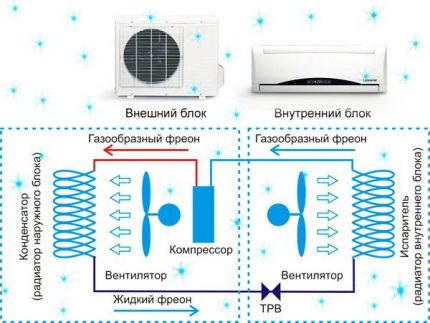
The refrigerant in a gaseous state (t + 10-20 ° C; pressure 3-5 atmospheres) comes from the evaporator to the compressor. There, the gas is compressed and heated (t + 75-90 ° C; pressure 15-25 atmospheres). Then it enters the capacitor.
Here it goes into a liquid state, because it is cooled by an external air stream, which is driven through a heat exchanger.
When the refrigerant leaves the condenser and moves to the temperature control device, it has a high pressure and a temperature of 12-20 ° C higher than the environment.
Typically, a temperature control device is a thin copper spiral tube. In this case, the cross section of the device for passing freon is regulated. By Bernoulli law, where the refrigerant travels faster, the pressure is lower. The pressure drop provides a decrease in the boiling point of the liquid and the active evaporation of the substance.
In the evaporator, where Freon then enters, it again becomes gas due to the active expansion and removal of heat from the air in the refrigerated room. The device is used precisely for the sake of this stage, which is the main one. Then the gas enters the compressor again. The cycle closes to repeat again and again.
Evaporating device: device principle
A remarkable feature of the evaporative device is that it does not use gases, the use of which negatively affects the environment. The operation of the device is not based on a change in the state of aggregation of the refrigerants, but on the evaporation of ordinary water.
The body of the device with a pallet is made of moisture-resistant materials that do not respond to sudden temperature changes.It contains all the nodes of the device.
The design is based on a water pump, which is used to saturate the cooling filter with moisture. The pump is equipped with a filling tank with valves through which water is supplied.
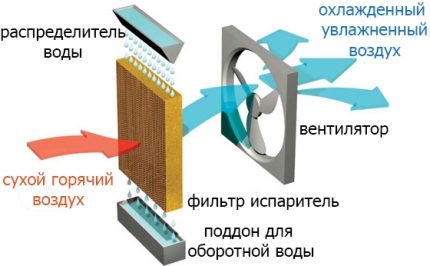
Cold water for the filter comes from the tank, where it is pumped from the pan. To enhance the cooling effect, ice can be put in a pan.
Cooling filters are used to increase the area of water evaporation, which helps to increase the efficiency of the device. As the material for their manufacture, cellulose or special polymers are used.
The honeycomb structure of such filters provides the maximum possible cooling of the air passing through them.
The fan helps to activate the movement of air masses and force them through the air, and then the cooling filter.
This device works like this:
- a fan draws warm outside air into the case;
- air flows through filters, where they are cleaned and saturated with water from the tank;
- water vapor cools and moisturizes the air that enters the room.
The drier the outside air, the more actively the process of water evaporation takes place, and the better the device works.
Pros and cons of factory air conditioners
In many regions of our country, people cannot survive the summer heat without air conditioning. These devices are needed and useful. No one will argue with this statement. But along with the advantages, they also have a number of disadvantages that you need to know in order to predict and reduce their negative impact.
So, let's start with the “pluses”:
- creating a comfortable temperature microclimate in the home;
- filtration of air masses;
- the use of humidifiers and ionizers in a number of modern models.
These benefits are obvious. It is they who make us make a positive decision when buying this device.
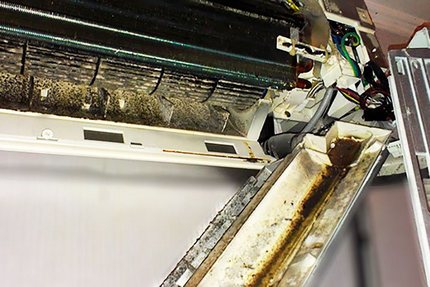
But there are also disadvantages":
- the device itself will not be cheap, but you will still have to pay for its installation and for maintenance;
- electricity consumption and, accordingly, bills for it will increase;
- dust extracted from the air accumulates on the filters, which contributes to the growth of microorganisms, for example, Legionella bacteria - the causes of serious lung disease;
- air conditioning without a humidifier helps to reduce humidity in the room, which negatively affects the mucous membranes of the nasopharynx and eyes, promotes skin aging;
- a cooled stream of air masses can cause colds;
- the noise emitted by the device can irritate people.
If the device is poorly looked after, it can transmit unpleasant odors that fill your entire home. Detailed information on the features of servicing the split system is given in this article.
So, it makes sense to try to make your own device that has the advantages of factory air conditioners and is devoid of at least a few of their shortcomings.
What can you do yourself?
I draw your attention to the fact that we do not strive to surpass factory products. It is unlikely that we will be able to achieve the same cooling capacity.
Our goal is to build a device that does not consume a lot of energy, is inexpensive, and, in case of inefficiency, can be sent to the box and the trash without regret. But imagine how self-made you will be pleased if successful!
Most home-made devices, as experience shows, consist of two main parts:
- a unit to reduce the ambient temperature;
- an element that contributes to the spread of the cooling effect throughout the room.
So let's figure out how to make an effective air conditioner at home from what we have at hand.
Ice paired with a fan
Simpler than this device can only be a wet sheet with which to curtain a window opening. Also, by the way, is a way to cool and moisten the air entering the room.
For its construction, plastic bottles or other containers filled with ice are needed. Well-proven flat containers with special coolers for cooler bags - cold accumulators.
They can be screwed to the fan grill with wire or placed in a basket fixed to the rods of this grill. The more ice, the better the cooling device.

The effectiveness of this design, consisting of ice in a tank and a fan, can also be improved by assembling it in a special way.
We will need:
- five-liter plastic water bottle with cap;
- computer fan - diameter 120 mm;
- four screws and a screwdriver;
- pre-frozen ice.
Two holes are made in the bottle opposite each other. One thing will be round: a fan is inserted into it so that it draws air into the tank. The fan must be rigidly fixed with screws on the surface of the bottle.
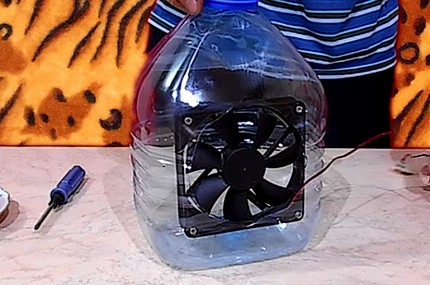
The second hole is made rectangular. In this case, only the bottom and side walls of the rectangle are cut. The resulting valve is bent up. Through a rectangular hole inside the bottle, ice is laid, the fan is turned on and that's it. You can enjoy the cool.
When the need for the device disappears, you can close its window with a valve to preserve the remnants of the cold.
We suggest you familiarize yourself with a device of a similar, but more complex and “long-playing” design in the video instruction block located at the bottom of the article.
Fan and copper tubes
If we are going to make a compact cooler from a fan with a protective grill and copper pipes through which water will move, then we should immediately focus on the topic of water.
It should be either running, or water should be placed in a bucket, which will become part of the device. If the house has a water meter, then the second option with media recycling is preferable.
One of the options for a successful tandem of ice with a fan and a copper coil will present the following selection of photos:
This useful homemade product will cool the air in the room by 5-7º in half an hour of productive work.
To work, we need:
- fan with front grill;
- a copper tube with a cross section of 6.35 mm and a length of 5-10 m;
- thin wire or flexible plastic clamps;
- flexible hose made of transparent plastic with an inner diameter of 6 mm;
- aquarium submersible pump (capacity 600-1000 liters per hour);
- bucket or thermal box (the latter is preferable);
- metal clamps;
- cold accumulators.
Flat containers filled with quick freezing liquid are the cold accumulators that are used in cooler bags, automotive thermoboxes and other products of a similar purpose to maintain the desired temperature.
As a filler, they may contain water-salt solutions, gel or silicone.
For our homemade silicone battery is best suited. If the tank into which it is placed is well insulated, then it will be able to maintain a temperature of 0 ... + 2 ° C in it for a week. As a thermobox, you can use a bucket, but not with a round, but with a rectangular section.
To enhance insulation (with a lid!), It is glued 3-4 cm thick with a layer of polystyrene foam from the outside and from the inside.

If everything you need is prepared, get to work.
We remove the front protective grill from the fan and fix the copper tube on it with plastic clamps. The more turns it is secured, the more efficient the device will be, but in everything you need to know the measure: the air flows from the fan should move freely between the turns of the tube.
The ends of the copper tube remain free. But the ends of the plastic clamps should be cut to make the product look more aesthetically pleasing. The grill is mounted on the fan, and the ends of the copper tubes are directed towards the location of the water tank.
Plastic transparent hoses are put on the copper ends and secured with metal clamps.
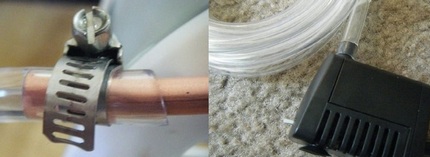
There will be two plastic hoses. They must be free to reach the cooling tank. The end of one of the hoses is connected to the pump nozzle. The second hose (long) is located in the tank. The tank is filled with cold water and ice.
There you can put the cold accumulators. It is better to drill holes for hoses and wires so that the lid hermetically seals the thermal box.
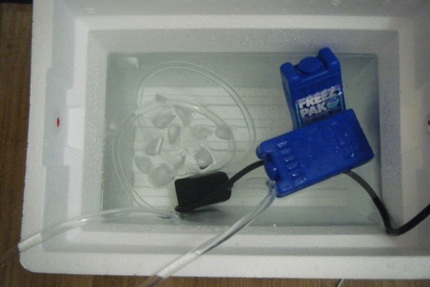
After turning on the pump and the fan in the network, water should begin to move freely through the hose to the fan, then through the copper pipe, giving off the cold spread by the fan, and again through the hose to the thermal box. If everything is so, the system is working properly.
Quick photo production guide
In fact, the presented options for climate devices are modernized fans. To inform them of high efficiency and provide a number of useful features along the way will not work anyway. However, they will even help to cope with the sweltering heat in an emergency.
For those who wish to build a climate device from waste materials, we offer just such an interesting model:
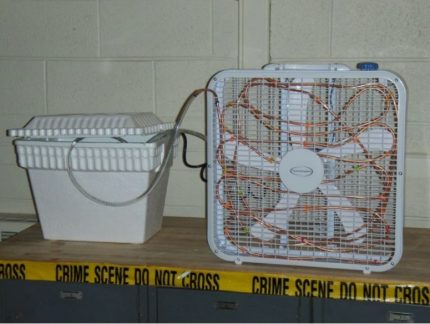
To assemble this device, you will need an axial fan with a removable grating panel, a copper tube, plastic ties, a submersible type mini pump and a portable refrigerator - a box with foam insulation.
After completing the assembly, we test the homemade by immersing the pump in a foam plastic refrigerator with water and ice. To verify the operation of the system, we measure the temperature in the room before starting work and after half an hour. The model will be improved by including in the working scheme fan speed controller.
Tricks with a cardboard box
The basis of this design is all the same desktop fan and ice. But the device is quite interesting, so we decided to show it to you. The best part is that all the valuable components of this device can be easily restored to their original position without losing their functionality.
We will need:
- a box of corrugated cardboard is large enough to fit in a large pan;
- the pan itself;
- desktop fan with protective grill;
- wide adhesive tape;
- gypsy needle and stern thread;
- scissors, clerical knife;
- ruler or tape measure and marker;
- ice.
From a corrugated cardboard box, we need to make a box without a bottom in the size of our pan. The pan should fit tightly into this box, that is, correspond to it in length and width, but in height the box must exceed the pan by 15-20 cm.
To do this, cut the box with a clerical knife and cut off the bottom and the lid of it. We turn off the box according to the markings, gluing its edges and ribs with tape with 2-3 layers.

There should be no holes in the walls of the box. From the remains of the corrugated cardboard we cut out the square box lid. It is better to make it two-layer.
In its center we mark a circle whose diameter should be 2-2.5 cm greater than the fan impeller span so that its blades freely enter the cut round hole and do not touch the edges during its rotation. We fix the cover in its place with tape.
At the level of the upper edge of the pan placed in the box, we cut a rectangle 3.5–4 cm high in its wall. The length of this “embrasure” may be different, but it should not reach 4 cm to each of the side edges of the box so that the structure retains rigidity.
From this cut-out, cooled air will go out. And for flow control you need to build blinds for it.
To do this, we cut out two strips from the corrugated cardboard, the length of which is less than the cutout by 4-5 mm, and the width is more than 5 mm. We connect these strips together at a distance with the help of a gypsy needle and harsh threads. Punctures in the upper strip are made at a distance of 7-8 mm from the edge, and in the lower - 12-15 mm.
We insert the blinds into the opening and fix each strip at three points. We do not tighten the threads, but fix them in knots.
Try moving your blinds with your finger. The design should move freely and not crumble when moving. Now you can start assembling the device. Place a rug or old cloth in several layers under the pan to keep the appliance quieter. The stability of the pan should not be affected.
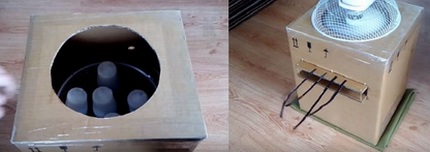
We put the pan and cover it with the front fan guard, with the concave side facing up. On a grid lay out pieces of pre-prepared ice. It is better to harvest it in plastic glasses, because large pieces melt more slowly than small ones. We cover the structure with a box.
Insert the fan with the blades down into the hole of the top cover. You can enable and verify the quality of work.
The melted ice turns into water, which must be poured out of the pan in time so that it does not leak out and soak the box. Otherwise, the fan may fall into the water, which will lead to a short circuit.
You can have a good look at the whole process of constructing this air conditioner by watching the video that we placed in a special block at the bottom of this article.
Plastic bottles and plywood sheet
This remarkable design does not need electricity and even frozen water. The only thing necessary for her work is a draft.
The principle of operation of the device is easier to explain with an example. Open your mouth wide and exhale sharply on your hand. The skin will feel warm. And now you need to stretch your lips with a tube and blow again with the same effort as the first time.
This time, an air stream cools your skin. If air passes through a narrow channel, then with instant expansion it cools.

We will prepare a sheet of cardboard, but better plywood. It should correspond to the size of the window opening, which we want to close with this design. We stock up on plastic bottles. From each of them we will need only the upper third with a cork. We cut it off.
By the way, plugs need to be removed, but not thrown away. They are useful to us for fixing bottles on the surface of the sheet.
We will need so many bottles so that they cover the entire surface of the sheet, but do not touch each other.To measure the holes for them, you can use a long pencil, which marks the center of the slot through the neck.
To drill a hole for a standard bottle, you need a crown with a diameter of 18 mm. Using a drill, we drill all the holes in turn.
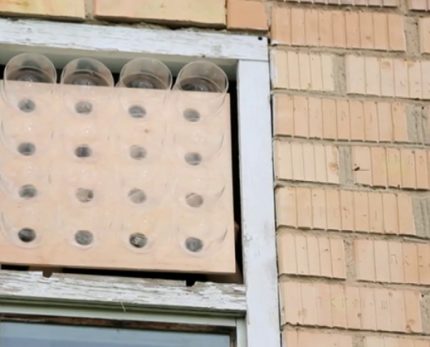
The cut-off upper parts of the bottles without plugs are inserted into the holes and fixed with their own plugs, in which the top is cut off. In this case, rings with internal thread are obtained that perfectly hold the segments of the bottles.
It remains only to install the finished air conditioner in the window opening with funnels outward. Specialists guarantee a decrease in temperature in the room by five degrees.
Fan Supplement
One of the obvious disadvantages of the previous device is that it deprives users of natural light in the room. In addition, there may be drafts in your area. Then use this notion.
To implement it, prepare:
- steady household fan;
- six plastic bottles;
- a sheet of thin plastic or thick cardboard - what you find;
- plastic tightening clamps;
- clerical knife;
- hot melt silicone.
The principle of operation of this cooler is the same as that of the previous model. Only in the window opening it is not necessary to mount it, and it can work in any room: it is portable.
The following photo instruction will familiarize you with the manufacturing process in the finest details:
All actions for cutting the base and cutting circles for attaching blanks from bottles should be done very carefully and carefully. If cut more than necessary, the workpiece will not firmly “sit” in the nest. True, there is still the opportunity to correct the error - you can correct the defect by gluing with tape. Further:
Now the home-made device, which should concentrate the air flows and enhance its movement, remains to be assembled and attached to the fan:
We cut off the upper part from the bottles, focusing on the label line to get the same lengths. Next we will make the basis. To do this, on a sheet of plastic or cardboard, draw a circle corresponding to the diameter of the fan. Using a clerical knife, cut out a circle.
On the resulting circle, we evenly arrange the segments of the bottles with the bell down. We circle the circumferences of the sockets and carefully cut them out. The result was a mounting plate.
We attach bottle sockets to the holes and fix them in such position with tape so that they do not change their position during gluing. We glue the bottles to the mounting plate, applying glue on both sides.
It remains only on the mounting plate to make holes between the bottles for fixing the plastic clamps with which the panel will be attached to the fan grill. We tighten the fasteners, cutting off their ends, otherwise they will interfere with the rotation of the blades.
If there is no time for experiments, and the issue of cooling the room becomes more and more relevant, then you can buy a practical and inexpensive model of a split system.
We have prepared a block of articles that will help in choosing a home air conditioner:
- How to choose a split system in an apartment and in a house: the best brands + recommendations to customers
- Mobile split systems: dozens of the best options for portable climate equipment
- Split system for 2 rooms: how the equipment is arranged and works + the nuances of choosing such a technique
- Split system inverter or conventional, which is better? Advantages and disadvantages + selection tips
Conclusions and useful video on the topic
This video shows the fastest and most affordable way to make an air conditioner from a five-liter plastic bottle.
The visual series that reproduces the process of creating a cooling device from a pan and a cardboard box will help you clarify all the nuances if something remains unclear.
This article presents the most simple and popular designs that anyone can build, but for those who like to apply their master’s skills, we also have something.
Air conditioning is a technically complex device, without which the summer life of modern urban residents is difficult and joyless. But this expensive device needs maintenance and power costs.
We offer you to build your own hands one of the above most popular devices in the people and use it. Perhaps the factory model will not seem to you as attractive as this budget homemade product.
Have experience making a home air conditioner? Please tell readers about your method of assembling the cooling unit. Comment on the publication, participate in discussions and add photos of your homemade products. The feedback block is located below.

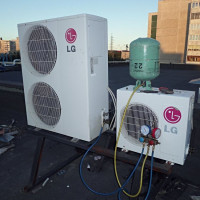 Refueling split systems: how to fill freon climate equipment with your own hands
Refueling split systems: how to fill freon climate equipment with your own hands  Maintenance of split systems: do-it-yourself cleaning, repair and refueling of HVAC equipment
Maintenance of split systems: do-it-yourself cleaning, repair and refueling of HVAC equipment  DIY split-system cleaning: routine inspection and maintenance
DIY split-system cleaning: routine inspection and maintenance 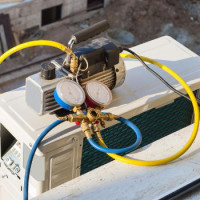 Do-it-yourself evacuation of the air conditioner: technology for work + valuable recommendations
Do-it-yourself evacuation of the air conditioner: technology for work + valuable recommendations 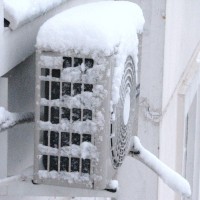 Is it possible to use air conditioning for heating in cold weather and how to prepare it for this job?
Is it possible to use air conditioning for heating in cold weather and how to prepare it for this job? 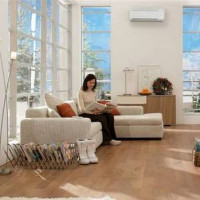 How to turn on the air conditioner for heating: the specifics of setting the system to heat
How to turn on the air conditioner for heating: the specifics of setting the system to heat  How much does it cost to connect gas to a private house: the price of organizing gas supply
How much does it cost to connect gas to a private house: the price of organizing gas supply  The best washing machines with dryer: model rating and customer tips
The best washing machines with dryer: model rating and customer tips  What is the color temperature of light and the nuances of choosing the temperature of the lamps to suit your needs
What is the color temperature of light and the nuances of choosing the temperature of the lamps to suit your needs  Replacement of a geyser in an apartment: replacement paperwork + basic norms and requirements
Replacement of a geyser in an apartment: replacement paperwork + basic norms and requirements
We have a couple of weeks just unbearable heat. At work, there is air conditioning, only they are saved. But the problem is that literally after a couple of hours in the room there is nothing to breathe, the head is like a cast-iron. We start to open, air and turn it on again. Options for air conditioners made by hand pleased with the simplicity and affordability. I even wanted to try to do it myself. I especially liked the option with a cooler, ice and a plastic eggplant. Everything ingenious is simple!
Frankly, I saw a lot in my life. I read even more lately all sorts of nonsense on the Internet. But this post just hit me in the heart. Of course, I now have air conditioning. And I, naturally, do not regret it, although we need it two months a year. But as I had never thought of such a simple and elegant idea ??! I am especially surprised when I look at my own fan, the same as the photo is captured, and next to it is a freezer. In the summer, just out of research interest, I’ll try the design to see how much space the room has, for how long there are enough bottles, what will be the real cooling effect.
Well, why immediately "nonsense." It is clear that with a real factory air conditioner such a home-made system can not be compared, but it works quite well. At the time of my student days, I made a device, something like in the material above - a fan and ice bottles. And she, indeed, saved in the almost forty-degree heat, only have time to change the bottles. By the way, for a better effect around the fan made a casing of cardboard and scotch tape. Otherwise, the fan grabbed not only the cold from the ice bottle, but also the hot air and part of the effect was lost. Still in advance it is worth putting a container into which condensate from a bottle will drain.
I will immediately answer both the author of the question and the commentator. I'll start with the last one. So, I understand that the delirium for the author is not this idea about a homemade air conditioner, but the various implementations that were offered on the Internet!
Regarding your “student” air conditioner, such non-tricky decisions in the form of ice bottles near the fan are the most popular solutions. Only many for some reason put them in front of the fan, and not behind, where the air intake takes place.
Now to the author of the question. The ideas in the article are really very good, plus everything is described in detail and with pictures.Of course, when there is air conditioning in the apartment, such homemade products cause laughter. Most of all I liked the idea with a copper coil and cold water in a bucket. As for me, this is the best option in terms of implementation and subsequent use. But it is better to buy air conditioning at a discount in winter, and then install it in the spring.